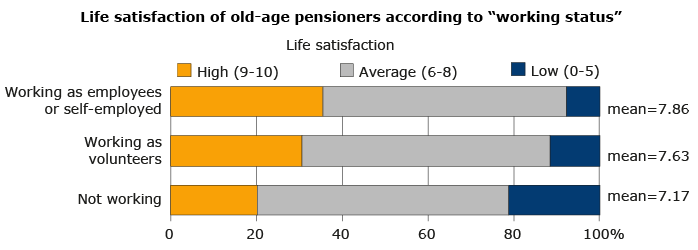Working old-age pensioners are satisfied with their life
Post-retirement work has become more common in Finland and in other countries in recent years. Older people who continue working after retirement have been found to be happier and healthier than those who are not working. This blog clarifies the association between post-retirement work and life satisfaction in Finland. The results are based on a postal survey conducted by the Finnish Centre for Pension in the autumn of 2017.
The survey shows that almost 14 per cent of Finnish old-age pensioners aged 63–74 are working as employees or self-employed and 20 per cent are working as volunteers.
Working old-age pensioners are a select group
Previous studies have shown that working as employees or self-employed is more common among younger old-age pensioners, those who are married or cohabiting, those with a higher education and those who have not been unemployed or on a disability pension before old-age retirement. The self-employed continue working relatively often after old-age retirement. Post-retirement work is also more common among men than women.
The differences are smaller or non-existing among old-age pensioners who work as volunteers. For example, volunteering is equally common among men and women, and among the self-employed and employees. The highest differences in volunteer work can be found in different educational groups: old-age pensioners with a higher education work more often as volunteers than do those with a primary education. In addition, those who work as volunteers are usually in good health.
Old-age pensioners working as employees or as self-employed more satisfied with life
Working old-age pensioners are more satisfied with life than non-working old-age pensioners. Life satisfaction is highest among those who work as employees or as self-employed. On average, those who work as volunteers are slightly less satisfied with life than are those who work as employees or as self-employed. Those old-age pensioners who are not working at all are clearly the least satisfied with life.

Life satisfaction of old-age pensioners according to “working status” (Excel)
Higher life satisfaction associated with good health and financial factors
The differences in life satisfaction between working and non-working old-age pensioners may be the result of many factors. I used an ordered logistic regression analysis to study the association between life satisfaction and post-retirement work. The results indicate that especially health, household income and housing tenure contribute to the differences in life-satisfaction between working and non-working old-age pensioners. When age, gender, marital status, education, retirement route as well as health, household income and housing tenure are controlled, working as an employee or as a self-employed is no longer a statistically significant factor.
The results of the study show that the differences in life satisfaction between old-age pensioners who work as employees or as self-employed and those who are not working at all are mainly due to differences in health, education or income. After controlling these factors, some differences in life satisfaction between volunteers and non-working old-age pensioners still exist. Therefore, other factors than those studied may impact on the differences in life satisfaction between old-age pensioners who work as volunteers and those who do not work at all. Such factors may be work-related or related to, for example, personality traits. People who seek to continue to work as volunteers after old-age retirement may have certain personality traits. Working as such can bring joy in life and may therefore have a positive effect on life satisfaction.
All-in-all, active pensioners are valuable resources for society. Many of them work because they find work interesting and social relationships important.
The study is based on survey data collected by the Finnish Centre for Pensions in 2017. The data included the responses of 1,356 old-age pensioners aged between 63 and 74. Old-age pensioners over 75 years were excluded since very few of them work.
The information on employment was based on separate questions about 1) working as an employee or as a self-employed and 2) working as a volunteer.
Life satisfaction is based on a question on how satisfied pensioners are with their life. The answers were rated on a scale from 0 to 10, where 0 means low satisfaction and 10 means high satisfaction. The replies were classified into three groups: 0–5 (low satisfaction), 6–8 (average satisfaction) and 9–10 (high satisfaction). Eurostat has used a similar classification.
References
Fasbender, U. & Wang, M. & Voltmer, J. & Deller, J. (2016) The Meaning of Work for Post-retirement Employment Decisions. Work, Aging and Retirement 2(1):12-23.
Kim, S. & Feldman, D.C. (2000) Working in retirement: The antecedents of bridge employment and its consequences for quality of life in retirement: Academy of Management Journal, 43,1195-1210.
Polvinen, A. & Kuivalainen, S. (2019). 63-74-vuotiaat vanhuuseläkkeellä työssäkäyvät – työssäkäynnin motiivit ja taloudellinen hyvinvointi (63–74-year-old working retirees on an old-age pension – motives for working and economic well-being). In Ahonen et al. Tutkimuksia eläkeläisten toimeentulokokemuksista ja taloudellisesta hyvinvoinnista (Studies on retirees’ perceived and overall economic well-being). Eläketurvakeskuksen tutkimuksia 02/2019: Helsinki.
Polvinen, A. & Rantala, J. & Kuivalainen, S. (2019) Vanhuuseläkkeellä ja työssä. Tutkimus vanhuuseläkeläisten työssäkäynnin yleisyydestä ja sosioekonomisista eroista (Retired on an old-age pension and working. Study on the frequency of working among old-age pension retirees and socioeconomic differences). Yhteiskuntapolitiikka 84:80-91.
Scherger, S (editor) (2015). Paid work Beyond Pension Age. Comparative Perspectives. Basingstoke: Palgrave Macmillan.
